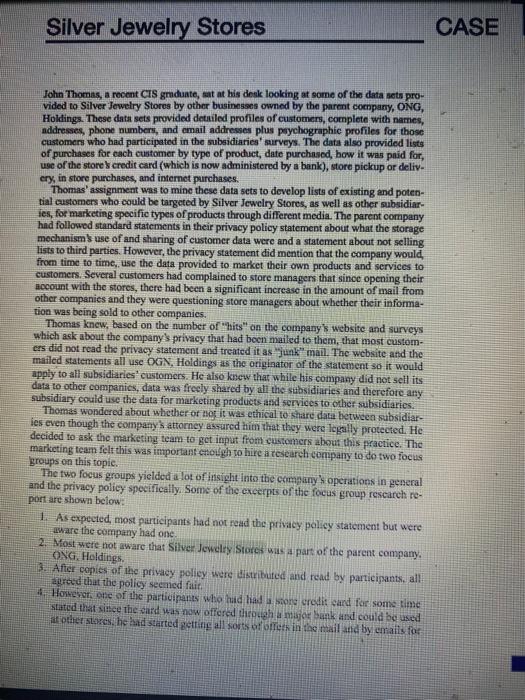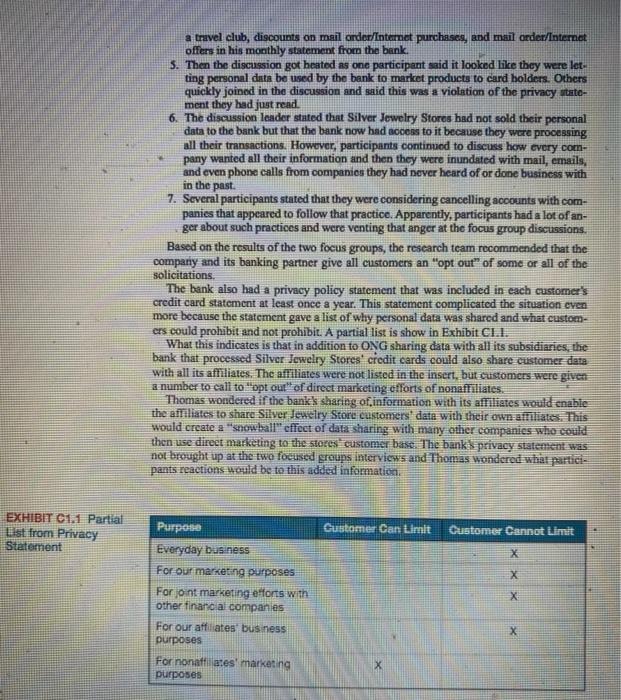John Thomas, a recent CrS gmduate, at at bis desk looking at some of the data sets provided to Silver Jewelry Stores by other businesses owned by the parent cocnpary, ONG, Holdings. These datit sets provided detuiled profiles of customers, complete with names, addresses, phone numbers, and email addresses phas peychographic profiles for those customers who had participated in the subsidiaries' surveys. The data also provided lists of purchases for each customer by type of product, date purchasod, bow it was paid for, use of the store s credit card (which is now administered by a bank), store piciup or deliv. ery, in store purchases, and internet purchases. Thonas' assignment was to mine these data sets to develop lists of existing and potential customers who could be targeted by. Silver Jewelry Stores, as well as other subsidiaries, for marketing specific types of products through different media. The parent company had followed standard statements in their privacy policy statement about what the storage mechanism's mse of and sharing of customer data were and a statement about not selling lists to third parties. However, the privacy statement did mention that the company would, from time to time, use the data provided to market their own products and services to customers. Several customers had complained to store managers that sinoe opening their \#ocount with the stores, there had been a significant increase in the amount of mail from other companies and they were questioning store managers about whether their informarion was being sold to other companies. Thomas knew, based on the number of "hits" on the company s website and surveys which ask about the company's privacy that had boon mailed to them, that most customcrs did not read the privacy statement and treated it as "junk" mail. The website and the matled statements all use 0GN, Holdings as the originator of the statement 30 it would apply to all subsidiaries' customers. He also knew that while his company did not sell its dats to other companies, data was frecly shared by ull the stbsidiaries and therefore any subsidiary could use the dats for marketing products asd services to other subsidiaries. Thomas wondered about whether of t of is was ethical to share data hetween subsidiaries even though the company's attorncy aszured him that they were legally protected. He: decided to ask the marketing team to get input from custemers abour this fractice. The marketing team felt this was important eatoigh wo hire a research conpany to do two focus groups on this topic. The two foeus groups yielded a lot of litsight into the ecimpliny s operations in general and the privacy policy specifically. Some of the excerpe of the focas group research report are shown below: 1. As expected, most participants had not read the privicy policy statcment but were unare the company had one. 2. Most were not aware that Silver Jewclry Stores wis a pars of the parent company. (3)G.Holdingh. 3. Affer copies of the privacy policy were bistyibuted and read by particigants. all airesed that the policy secmed fatif In Hortesore ofe of the participants who had has a sione crodit sand fors some rime a travel club, discounts on mail anderifintamet purchsses, and mail arderfintermet offers in his monthly statement from the bank. 5. Then the discussion got heatod as one participant said it looked like they were letting personal data be used by the bank to market products to card holders. Others quickly joined in the discussion and said this was a violation of the privacy statement they had just read. 6. The discussion leader stated that Silver Jewelry Stores had not sold their personal data to the bank but that the bank now had access to it because they ware processing all their transactions. Howover, participants continuod to discuss how every company wanted all their information and then they were inundated with mail, cmails, and even phone calls from companies they had never heard of or done business with in the past. 7. Several participants stated that they were considering cancelling accounts with companies that appeared to follow that practice. Apparently, participants had a lot of anger about such practices and were venting that anger at the focus group diseussions. Based on the results of the two focus groups, the research team rocommended that the company and its banking partner give all customers an "opt out" of some or all of the solicitations. The bank also had a privacy policy statement that was included in each customer's credit card statement at least once a year. This statement complicated the situation cven more because the statement gave a list of why personal data was shared and what customers could prohibit and not prohibit. A partial list is show in Exhibit CI.1. What this indicates is that in addition to ONG sharing data with all its subsidiaries, the bank that processed Silver Jewelry Stores' credit cards could also share customer dasa with all its affiliates. The affiliates werenot listed in the insert, but customers were given a number to call to "opt out" of direct marketing efforts of nonaffiliates. Thomas wondered if the banks sharing of, information with its affiliates would enable the affiliates to share Silver lewelry Store customers' data with heir own-affiliate- This would create a "stomhall" effect of dala siariny with many other companies who ecture then use direet marketing to the stores customer bast. The banks privacy statentent was not brought up at the two focused greups incerviews and Thomas wonderod what partictpants reactions thould be to this added information. ECHIBIT Ci.1 Partial Elst from Privacy Statement 1. Characterize the differences between utilitarlanism and the rights principle. Discuss if it is cver morally acceptable to lie. Explain your









